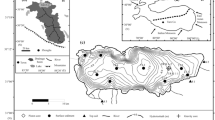Abstract
A pollen record of a Late Holocene sediment core from the Mexican Caribbean coast (Quintana Roo) shows the development and changes of a mangrove system. Humid conditions seem to have persisted for the period approximately 2500–1500 14C yr BP (pollen zone I), and mangrove Rhizophora mangle dominated with a good representation of elements from the nearby semi-evergreen tropical forest. During the period approximately 1500–1200 14C yr BP (pollen zone II) the mangrove Conocarpus erecta dominated. R. mangle almost disappeared and other taxa appeared, suggesting drier climatic conditions and generally more open vegetation. This dry period coincided with the period of the Maya cultural decline. The following period (pollen zone III, approximately 1200–1000 14C yr BP) was characterized by the recovery of R. mangle, indicating more humid conditions than in the preceding pollen zone. Pollen zone IV (approximately 1000 14C yr BP till present) suggests a drier period reoccuring with C. erecta; this marks the transition to present day conditions.
Similar content being viewed by others
References
Curtis, J. H., Hodell, D. A. & Brenner, M. 1996. Climate variability on the Yucatan Peninsula (Mexico) during the past 3500 years, and implications for Maya Cultural Evolution. Quater. Res. 46: 37-47.
Duivenvoorden, J. 1991-1992. Pollen Diagram 2.0. Hugo de Vries Laboratory, University of Amsterdam.
Faegri, K. & Iversen, J., 1975. Textbook of Pollen Analysis, 3rd Ed. Blackwell, Oxford, 295 pp.
Goman, M. & Byrne, R. 1998. A 5000-year record of agriculture and tropical forest clearance in the Tuxtlas, Veracruz, Mexico. Holocene 8: 83-89.
Henderson, J. 1997. The world of the ancient Maya. Cornell University. John Murray, London, 329 pp.
Hodell, D. A., Curtis, J. H., Jones, G. A., Higuera-Gundy, A., Brenner, M., Binford, M. W. & Dorsey, K. T. 1991. Reconstruction of Caribbean climate change over the past 10,500 years. Nature 352: 790-793.
Hodell, D. A., Curtis, J. H. & Brenner, M. 1995. Possible role of climate in the collapse of Classic Maya civilization. Nature 375: 391-394.
Islebe, G. A., Hooghiemstra, H., Brenner, M., Curtis, J. H. & Hodell, D. A. 1996a. A Holocene vegetation history from lowland Guatemala. Holocene 6: 265-271.
Islebe, G. A., Hooghiemstra, H. & van' t Veer, R. 1996b. Holocene vegetation and water table history from two bogs of the Cordillera de Talamanca, Costa Rica. Vegetatio 124: 155-171.
Leyden, B. W. 1984. Guatemalan forest synthesis after Pleistocene aridity. Proc. Natl. Acad. Sci. USA 81: 4856-4859.
Leyden, B. W., Brenner, M. A., Whitmore, T., Curtis, J. H., Piperno, D. & Dahlin, B. 1996. A record of long and short-term climatic variation from northwest Yucatan: Cenote San Jose Chulchacá. Pp. 30-50. In: Fedick, S. L. (ed.), The managed mosaic: Ancient Maya Agriculture and Resource Use. University of Utah Press.
Leyden, B. W., Brenner, M. & Dahlin, B. H. 1998. Cultural and climatic history of Coba, a lowland Maya city in Quintana Roo, Mexico. Quater. Res. 49: 111-122.
Metcalfe, S. E., O'Hara, S. L., Caballero, M. & Davies, S. J. 2000. Records of Late Pleistocene-Holocene climatic change in Mexico-a review. Quater. Sci. Res. 19: 699-721.
Miranda, F. 1958. Estudios acerca de la vegetación. Instituto Mexicano de Recursos Naturales Renovables México.
Palacios, C. P., Ludlow-Wiechers, B. & Villanueva, G. R. 1991. Flora palinológica de la Reserva de Sian Kaán, Quintana Roo, México. CIQRO, Quintana Roo, México.
Sánchez, S. O. 2000. Análisis estructural de la selva del jardin botánico. In: Sánchez, S. O. & Islebe, G. A. (eds.), El Jardín Botánico Dr Alfredo Barrera Marín: Fundamento y estudios básicos. ECOSUR. CONABIO.
Sánchez, S. O. & Islebe, G. A. 1999. Hurricane Gilbert and structural changes in tropical forest in southeastern Mexico. Glob. Ecol. Biogeogr. 8: 29-37.
Sánchez, S. O. & Islebe, G. A. in press. Tropical forest communities in southeastern Mexico. Plant Ecol.
Vaughan, H. H., Deevey, E. S. & Garrett-Jones, S. E. 1985. Pollen stratigraphy of two cores from the Petén Lake District. Pp. 73-89. In: Pohl, M. (Ed.), Prehistoric lowland Maya environment and subsistence economy. Harvard University Press, Cambridge.
Whitmore, T. J., Brenner, M., Curtis, J., Dahlin, B. & Leyden, B. 1996. Holocene climatic and human influences on lakes of the Yucatan Peninsula, Mexico: An interdisciplinary, paleolimnological approach. Holocene 6: 273-287.
Author information
Authors and Affiliations
Rights and permissions
About this article
Cite this article
Islebe, G., Sánchez, O. History of Late Holocene vegetation at Quintana Roo, Caribbean coast of Mexico. Plant Ecology 160, 187–192 (2002). https://doi.org/10.1023/A:1015865932012
Issue Date:
DOI: https://doi.org/10.1023/A:1015865932012




